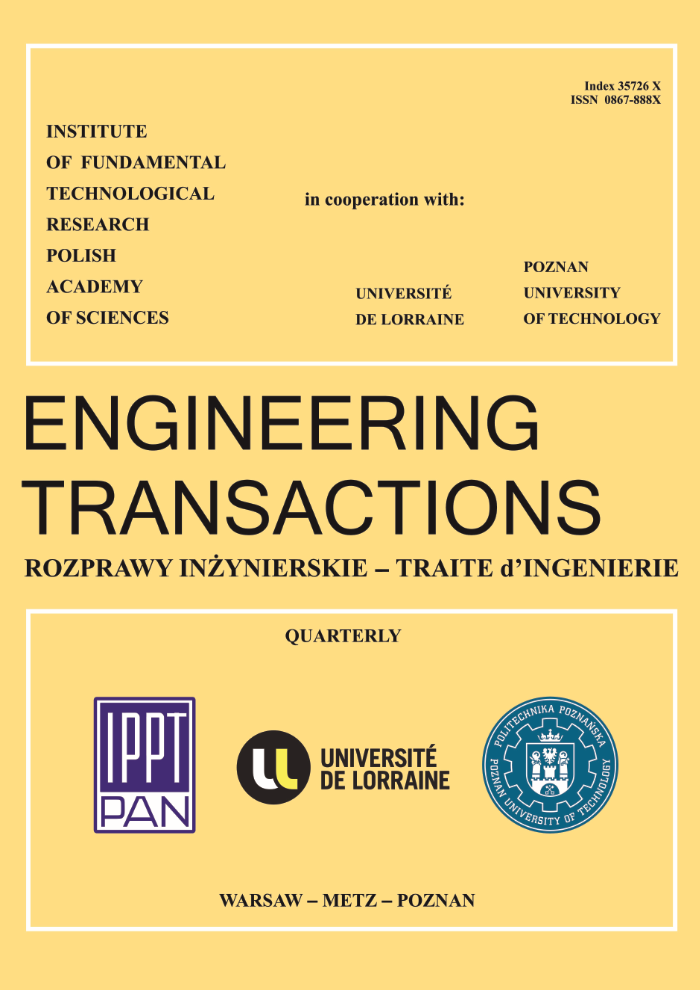The Initial Velocity of a Metal Plate Explosively-Launched from an Open-Faced Sandwich (OFS)
Abstract
Using analytic solutions for one – dimensional plane boundary value problems related to the launching of solids by detonation products (DPs) of high explosives, algebraic formulae which define the displacement and velocity of a metal plate launched by expanding DP from an open-faced sandwich (OFS) are derived. In addition, the variations of the mechanical parameters of displacement, velocity and density versus the Lagrangian coordinate of expanding DP gases during the launching of the metal plate from the OFS are defined. Variations of these mechanical parameters are also described by algebraic formulae. From analysis of the obtained results, it follows that Gurney’s assumptions of the linear velocity profile of constant – density DP gases significantly deviates from conventional theory of gas dynamics. Gurney’s assumptions introduce a serious error of estimated metal plate velocity (about several dozen percent).Keywords:
metal launching, Gurney’s formula, gas dynamics, open-faced sandwichReferences
1. Walters W.P., Zukas J.A., Fundamentals of shaped charges, John Wiley and Sons, New York – Chichester – Brisbane – Toronto – Singapore, 1989.
2. Gurney R.W., The initial velocities of fragments from bombs, shells and grenades, BRL Report No 405, Aberdeen Providing Ground, pp. 1–11, 1943.
3. Gurney R.W., Fragmentation of bombs, shells and grenades, BRL Report 635, March 1947.
4. Henry J.G., The Gurney formula and related approximations for the high-explosive deployment of fragments, Hughes Aircraft Company, Culver City, CA, Report No. PUB – 189, April (AD 813398), 1967.
5. Hirsch E., Improved Gurney formulas for exploding cylinders and spheres using hard core approximation, Propellants, Explosives, Pyrotechnics, 11(3): 81–84, 1986.
6. Jones G.E., Kennedy J.E., Berthof L.D., Ballistics calculations of R.W. Gurney, American Journal of Physics, 48(4): 264–269, 1980.
7. Kennedy J.E., Gurney energy of explosives: estimation of the velocity and impulse imparted to driven metal, Sandia National Laboratories, Report No. SC-RR-70-790, December 1970.
8. Włodarczyk E., On hydrodynamic stationary theory of jet formation, Journal of Technical Physics, 35(3): 241–252, 1994.
9. Włodarczyk E., The impact of direction and velocity of the detonation wave and the liner apex angle on parameters of a shaped charge jet and slug as well as an explosively formed penetrator, Journal of Technical Physics, 35(4): 393–413, 1994.
10. Włodarczyk E., Influence of casing and liner inertia of wedge cumulative war-head on displacement velocity of their explosively driven elements, and on active mass of explosive, Journal of Technical Physics, 43(1): 19–33, 2002.
11. Włodarczyk E., Fundamentals of explosion mechanics in Polish. , WN PWN, Warszawa, 1994.
12. Cook M.A., The science of high explosives, Reinhold Publ. Corp., London, 1958.
13. Ficket W., Davis W.C., Detonation, University of California Press, Berkeley, 1979.
14. Cheret R., Detonation of condensed explosives, Springer-Verlag, New York, 1993.
15. Włodarczyk E., The backward launching of solids by products of detonation, Journal of Technical Physics, 41(2): 101–119, 2000.
16. Włodarczyk E., The closed form solution of the Darboux boundary value problem for backward driving of solids by the high explosive, Journal of Technical Physics, 42(1): 5–21, 2001.
2. Gurney R.W., The initial velocities of fragments from bombs, shells and grenades, BRL Report No 405, Aberdeen Providing Ground, pp. 1–11, 1943.
3. Gurney R.W., Fragmentation of bombs, shells and grenades, BRL Report 635, March 1947.
4. Henry J.G., The Gurney formula and related approximations for the high-explosive deployment of fragments, Hughes Aircraft Company, Culver City, CA, Report No. PUB – 189, April (AD 813398), 1967.
5. Hirsch E., Improved Gurney formulas for exploding cylinders and spheres using hard core approximation, Propellants, Explosives, Pyrotechnics, 11(3): 81–84, 1986.
6. Jones G.E., Kennedy J.E., Berthof L.D., Ballistics calculations of R.W. Gurney, American Journal of Physics, 48(4): 264–269, 1980.
7. Kennedy J.E., Gurney energy of explosives: estimation of the velocity and impulse imparted to driven metal, Sandia National Laboratories, Report No. SC-RR-70-790, December 1970.
8. Włodarczyk E., On hydrodynamic stationary theory of jet formation, Journal of Technical Physics, 35(3): 241–252, 1994.
9. Włodarczyk E., The impact of direction and velocity of the detonation wave and the liner apex angle on parameters of a shaped charge jet and slug as well as an explosively formed penetrator, Journal of Technical Physics, 35(4): 393–413, 1994.
10. Włodarczyk E., Influence of casing and liner inertia of wedge cumulative war-head on displacement velocity of their explosively driven elements, and on active mass of explosive, Journal of Technical Physics, 43(1): 19–33, 2002.
11. Włodarczyk E., Fundamentals of explosion mechanics in Polish. , WN PWN, Warszawa, 1994.
12. Cook M.A., The science of high explosives, Reinhold Publ. Corp., London, 1958.
13. Ficket W., Davis W.C., Detonation, University of California Press, Berkeley, 1979.
14. Cheret R., Detonation of condensed explosives, Springer-Verlag, New York, 1993.
15. Włodarczyk E., The backward launching of solids by products of detonation, Journal of Technical Physics, 41(2): 101–119, 2000.
16. Włodarczyk E., The closed form solution of the Darboux boundary value problem for backward driving of solids by the high explosive, Journal of Technical Physics, 42(1): 5–21, 2001.







